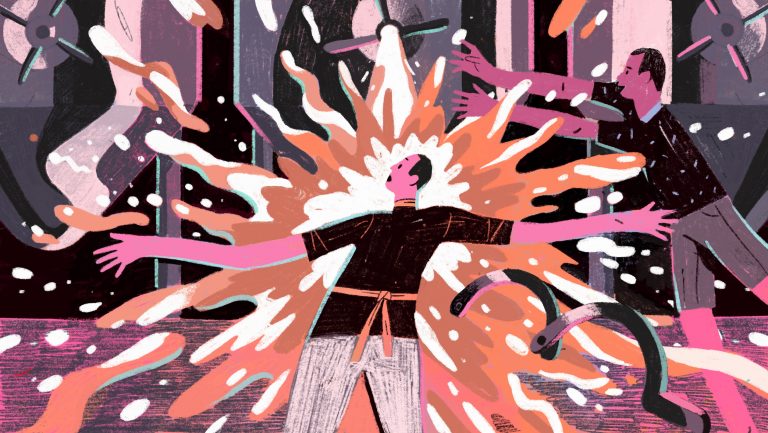Mishaps in the brewing world are not uncommon. Breweries are manufacturing businesses that require a combination of agricultural ingredients, complex machinery, human expertise, and hard physical labor to produce a product. Many brewers at times have had to dump batches of varying sizes that weren’t quite right. Navigating regulatory difficulties and cease-and-desist letters over beer names are also common challenges. Things can, and do, go wrong.
SevenFifty Daily recently spoke with personnel at breweries large and small to gather a handful of the most outrageous behind-the-scenes stories brewers were willing to spill. (Many of these incidents happened to new brewers, proving that training is paramount.) Equipment failures, delayed or incorrect deliveries of ingredients, and of course, human error are all part and parcel of an industry that depends on smoothly running systems for consistent, quality production. From botched recipes to projectile beer—and worse, these are the brewery mishaps they shared.

Don’t miss the latest drinks industry news and insights. Sign up for our award-winning newsletters and get insider intel, resources, and trends delivered to your inbox every week.
“The funniest thing I’ve ever seen was when a cellarman accidentally took off a two-inch tri-clamp on the wrong side of the valve on a 20-barrel tank. A column of beer blasted out of the tank and hit him squarely in the chest. It didn’t knock him to the ground, but his arms shot back. He was flailing like a Muppet, with beer spraying in every direction.
“Luckily, I was only a few feet away, so I grabbed the gasket and valve and slammed it back on the tank. The head brewer was on the walkway of the boil kettle, and he jumped down and threw the tri-clamp back on. We managed to save most of the tank, but our buddy was awestruck by what happened. Needless to say, he checked tri-clamps very closely after that.”
—Justin Tate, brewer, BearWaters Brewing Company, Canton, North Carolina
“We had brewed our amber the previous day into the tank we call Spock. This day we brewed into Wil Wheaton, the tank in front of Spock. I had heat transfer all hooked up, except for the one line from the kettle to the pump and the one from final stage of heat transfer to the tank. Lines were all sanitized. Ready to go! I hooked up the hose from the kettle to the pump and sliced my palm open with the hose clamp.
“Well, the show must go on. So I start heat transfer, run the sanitizer out, and beer comes out. Yay, it’s time! I proceed to hook up to Spock and put about a third of a barrel of our strong honey wheat into it. I tried to open the manway to pitch yeast. Beer came out as I cracked the seal. I had put honey wheat on top of the amber. I yelled for the brewmaster and he laughed—a lot. We stopped heat transfer, switched to Wil, and I finished the day with my tail between my legs. More than a year later, I announce, loudly, which tank I’m putting beer into with every brew!”
—Becky Bottoms, brewer, Silverking Brewing Co., Tarpon Springs, Florida
“I worked at a brewery that had plastic fermenters on wheels that we would roll into a temperature-controlled room for fermentation. We had one fermenter with a triangle-shaped base, so there were only three wheels on the bottom. That fermenter contained a beer I’d brewed for Women’s Brew Day. I was on vacation and got a text from my boss, saying that when the fermenter was moved out of the cold room, the front wheel hit a divot in the floor and the entire thing spilled sideways. They were really sorry, but the entire brew was gone. I was devastated.”
—Erika Raye, Quality Assurance/Quality Control coordinator, Mikkeller Brewing San Diego
“We were repurposing an old warehouse to expand the brewery, and we had to clear out goods and machinery to make way for our own stuff. As items were being removed, one of our staff came across a pile of dynamite. He freaked out and immediately called the fire department. One of the firemen came in, looked at the dynamite, then grabbed a stick of it and started to bang it hard on a concrete edge. Our poor Highland guy almost had a heart attack! Nothing happened, though, and he asked if the fireman was messing with him. The answer was yes. The fireman recognized that the dynamite was a fake movie prop and had some fun with our poor guy. The building was formerly the site of a movie set and thus it made sense—after the fact.”
—Oscar Wong, founder, Highland Brewing Company, Asheville, North Carolina
“I used to work in a 120-barrel brewhouse that was highly automated. It had safety interlocks and wing nuts to hold things closed on the hop-dosing tanks. I was a new brewer using fancy equipment, and we were understaffed. I loaded up the hops and ran up to the brew deck. Twenty-five minutes later I pushed a button to start the transfer. I suddenly heard screaming and immediately knew what was happening. The safety locks indicated that everything was okay, but they weren’t connected to the wing nuts, which I hadn’t secured. I ran back down, hoping not to see anyone writhing in pain.
“Luckily, no one had been near enough to get hit with boiling wort. But everyone I worked with, my entire peer group, was standing there watching. There was lots of laughter. It did teach me that no matter what—even if you’re going to delay a national rollout—always double-check everything on brew day!”
—Ray Dobens, nationwide brewery process and staffing consultant, whose clients include breweries like Ponysaurus and Lake Norman Brewing in North Carolina and Bald Birds and Blue Stripe in Pennsylvania
“I was an inexperienced brewer working at a poorly designed brewpub in 1989. One day I found myself in a hospital bed, knowing that the next day they would wheel me into surgery, shave my head, and use skin from my scalp to try to rebuild the skin that had been permanently burned off my left foot and leg in a serious on-the-job brewing accident.
“I had mashed in and was pumping 50 gallons of boiling water over to the liquor back. I ran down the hallway to turn off the pump switch, grabbed my rubber gloves, and began to take off the tri-clamp. I did not stop to look into the manway at the top of the kettle. The pressure of the water behind that cap pushed my hands back, steam poured out, and time slowed down. I suddenly had 50 gallons of boiling water gushing at me. I squeezed into the corner between the kettle and the railing. The brewery, built for looks, had no escape plan but stairs and railings everywhere. I moved to go around the railing and up the steps and got hit hard with boiling water, which filled up my left rubber boot. I was trapped. I knew if I didn’t get out of there, I would die.
“I tried slipping between the bars of the railing. Luckily, I was small enough to make it. I got up the steps and immediately took off my boots as I walked down the hallway, calling for help. My legs were bright red, the skin hanging in driplike formations. I couldn’t move my left foot. I thought they would have to amputate it. I spent three weeks in the hospital after surgery. Luckily, I healed, and despite the scars, I stayed in brewing. I have accomplished all I set out to do—and more.”
—Teri Fahrendorf, Malt Innovation Center manager, Great Western Malting, and founder, Pink Boots Society, Portland, Oregon

Dispatch
Sign up for our award-winning newsletter
Don’t miss the latest drinks industry news and insights—delivered to your inbox every week.
Anne Fitten Glenn is a writer, reporter, and communications consultant based in Asheville, North Carolina. She has authored two books: Western North Carolina Beer: A Mountain Brew History and Asheville Beer: An Intoxicating History of Mountain Brewing. Glenn has been writing about business, food, and beverages for more than two decades. Follow her on social media at @brewgasm.







